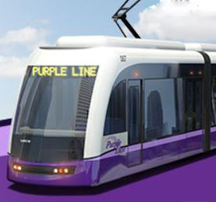The Corridor Cities Transitway
The Corridor Cities Transitway was originally planned as a two-lane busway that follows a C-shaped route from Shady Grove to Metropolitan Grove. Governor O'Malley announced on May 11, 2012 that the transitway will be a busway rather than light rail.
Only the segment of the transitway south of Metropolitan Grove is moving forward. The Maryland Transit Administration disclosed this decision at a community meeting on Jan. 30, 2013 and then issued a new map showing this shortened route. Extension to Germantown and south of Clarksburg will not be considered until some undetermined future date, after the density of population and jobs increases.
The Action Committee for Transit believes that the Corridor Cities Transitway should be constructed as light rail. Better rail transit is badly needed north of Shady Grove. However, even if built to its full length as rail this line by itself would not be a solution to the upcounty's transportation needs. It would not provide the access to the Metrorail system that the upcounty wants and needs. Only by building a comprehensive rail system for the upcounty can the full value of the Corridor Cities Transitway be realized.
The principal limitation is that it will not take people from Germantown and Clarksburg to the Red Line. Residents of these areas would still have to take a bus on I-270 to reach Shady Grove even after the transitway reaches their area. The transitway will be too slow because the route detours far to the west and vehicles will stop at many red lights.
Another problem is that as currently planned, the transitway will terminate at a parking lot on I-270 next to the Comsat building. It should extend into Clarksburg town center, where it would be reachable on foot.
At a public hearing on the Corridor Cities Transitway on Dec. 15, 2010, ACT made the following points:
- The I-270 corridor has overinvested in roads and underinvested in transit, leaving islands of walkability like Kentlands and Germantown Town Center surrounded by inhospitable sprawl. Priorities have to be reversed to create a more livable upcounty and to give residents an alternative to the automobile. This should begin by setting aside plans to widen I-270 and studying all-transit alternatives.
- The Corridor Cities Transitway should be built as light rail because a busway will not make the planned future development transit-oriented. Moreover, a bus transitway would largely duplicate the faster bus service running parallel to it on I-270. It would add little value for travel from Germantown and Clarksburg to Shady Grove. And light rail has many other advantages over buses.
- The planned route has value as part of a larger network, in which the transitway provides local service that feeds into faster long-distance service. Connections are needed to the Red Line at Germantown in addition to Shady Grove and to all-day MARC service at Metropolitan Grove. To make this a reality, the MARC expansion plan needs to be a high priority.
A further concern is that the design of new development planned along the transitway may be hostile to pedestrians and discourage transit use. As discussed in ACT's 2009 testimony, rhetoric about transit-oriented development is not matched by the specifics of the master plan for the corridor. More recent developments - such as Johns Hopkins' plan to build a 150-foot-wide roadway through its Belward Farm development - continue to be troubling.
Real estate developers, led by Johns Hopkins University, are pushing to further cut costs by eliminating bridges from the truncated transitway and sending the buses through intersections in regular traffic. This plan was already in the works while the developers were promoting the bus alternative as being just as fast as rail.
Our Vision


